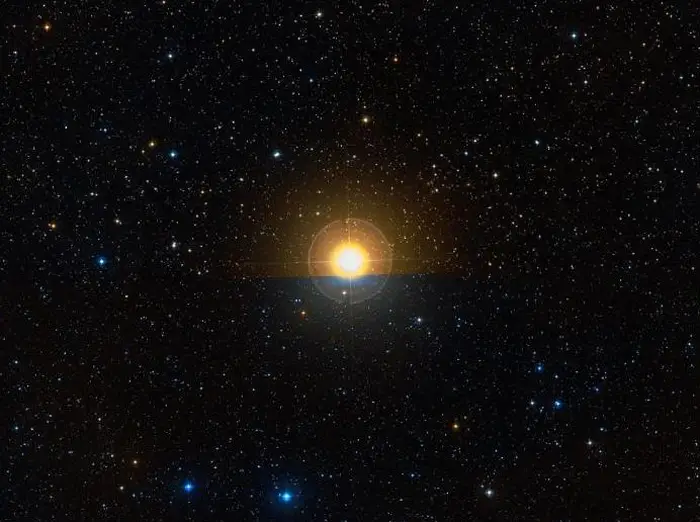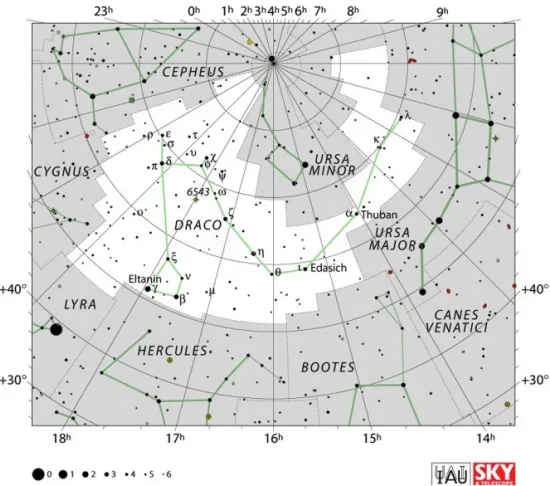Altais, Delta Draconis (δ Dra), is a yellow giant star located 97.8 light-years away in the northern constellation Draco. With an apparent magnitude of 3.07, it is the fourth brightest star in Draco, after Eltanin, Athebyne and Rastaban. The evolved star is part of the constellation figure of the celestial Dragon.
Star type
Altais is a yellow giant with the spectral class G9 III. It has a mass of around 1.70 solar masses and has expanded to a size of 10.62 solar radii as it evolved away from the main sequence. With a surface temperature of 4,831 K, the helium-fusing giant is 59 times more luminous than the Sun. It is a faster spinner than the Sun, with a projected rotational velocity of 8 km/s. It has an estimated age of 1.66 billion years.
With 170% of the Sun’s mass, Delta Draconis is not massive enough to end its life as a supernova. Instead, like the Sun, it will eventually expel its outer gaseous envelope to form a planetary nebula. The stellar remnant will cool and fade for billions of years as a dim white dwarf.

Altais (Delta Draconis), image credit: ESO/Digitized Sky Survey 2 (CC BY 4.0)
Facts
Shining at magnitude 3.07, Delta Draconis is on average the 187th brightest star in the sky. It is only slightly fainter than Seginus in the constellation Boötes, Dabih in Capricornus, Mebsuta in Gemini, and Tania Australis in Ursa Major. It outshines Eta Sagittarii in Sagittarius, Zeta and Nu Hydrae in Hydra, Lambda Centauri in Centaurus, and the Persian (Alpha Indi) in Indus.
Altais has a faint 12th magnitude companion at a separation of 82 arcseconds. If the two stars form a physical binary system, the companion is a red dwarf of the spectral type M1 V. If the stars are related, they are separated by at least 2,500 astronomical units (Earth – Sun distances) and have an orbital period of at least 75,000 years.
The north ecliptic pole is located roughly midway between Altais and Aldhibah (Zeta Draconis).
Altais is the north pole star on the dwarf planet Ceres. Seen from Ceres, the star lies only 1.5 degrees from the pole.
Name
The traditional name Altais (pronunciation: /ælˈteɪ.ɪs/) comes from the Arabic Al Tāis, meaning “the goat.” The name comes from an old Arabic asterism formed by Delta Draconis with Pi, Rho and Epsilon Draconis.
A 1971 NASA catalogue mentions that Tais or Al Tais was a name used for three stars: Delta Draconis (Altais), Pi Draconis (Tais I), and Rho Draconis (Tais II). Epsilon Draconis, which was also part of the Goat asterism, was excluded.
The International Astronomical Union’s (IAU) Working Group on Star Names (WGSN) approved the name Altais for Delta Draconis on August 21, 2016.
Delta Draconis was historically also known as Aldib and Nodus Secundus (Nodus II). It marks the second of the four twists or knots in the constellation figure of the celestial Dragon.
In traditional Chinese astronomy, Altais was called 天廚一 (Tiān Chú yī), the First Star of Celestial Kitchen. It formed the Celestial Kitchen asterism with Alsafi (Sigma Draconis), Epsilon Draconis, Rho Draconis, 64 Draconis, and Pi Draconis. The asterism represented the general officers’ kitchen. It was part of the larger Purple Forbidden Enclosure, which represented the imperial court.
Location
Altais is relatively easy to find on a clear, dark night. It is the brightest point of light roughly halfway between Polaris (the North Star) in Ursa Minor and Vega in Lyra. It appears along the imaginary line extended from Rastaban through Grumium.
Rastaban and Grumium form the head of the Dragon with Eltanin and Kuma. Eltanin and Rastaban mark the Dragon’s eyes and can be found by drawing a line through the beam of the Northern Cross in Cygnus.
Alternatively, a line through the base of the House of Cepheus points in the general direction of Delta Draconis.
At declination +67° 40’, Altais never rises above the horizon for observers south of the latitude 22° S.

Location of Altais (Delta Draconis), image: Stellarium
Constellation
Altais is located in the northern constellation of Draco. Representing the mythical dragon Ladon, who guarded the gardens of the Hesperides in Greek mythology, Draco is one of the ancient constellations listed by the Greco-Roman astronomer Claudius Ptolemy of Alexandria in his Almagest in the 2nd century AD.
Occupying an area of 1,083 square degrees of the far northern sky, Draco is the fourth largest northern constellation and the eighth largest of the modern 88 constellations. For northern observers, the celestial Dragon is visible throughout the year. It winds around Polaris and the northern celestial pole.
The stars of Draco do not stand out in the sky. The constellation’s luminary, the orange giant Eltanin (Gamma Draconis), has an apparent magnitude of 2.23 and lies 154.3 light-years away.
Other notable stars in Draco include the yellow bright giant or supergiant Rastaban (Beta Draconis), the orange giants Grumium (Xi Draconis) and Edasich (Iota Draconis), the blue giant Aldhibah (Zeta Draconis), the yellow giants Athebyne (Eta Draconis) and Omicron Draconis, and the multiple star system Alrakis (Mu Draconis).

Draco constellation map by IAU and Sky&Telescope magazine (Roger Sinnott & Rick Fienberg) (CC BY 3.0)
Deep sky objects in the constellation include the Spindle Galaxy (M102, NGC 5866), the Splinter Galaxy (NGC 5907), the Tadpole Galaxy (Arp 188), the Cat’s Eye Nebula (NGC 6543), the Draco Triplet of galaxies, and the Dolphin Galaxy (NGC 6670).
The best time of the year to see the stars and deep sky objects of Draco is during the month of July, when the Dragon constellation climbs higher above the horizon in the early evening. The entire constellation can be seen from locations north of the latitude 15° S.
The 10 brightest stars in Draco are Eltanin (Gamma Dra, mag. 2.23), Athebyne (Eta Dra, mag. 2.73), Rastaban (Beta Dra, mag. 2.79), Altais (Delta Dra, mag. 3.07), Aldhibah (Zeta Dra, mag. 3.17), Edasich (Iota Dra, mag. 3.29), Chi Draconis (mag. 3.57), Thuban (Alpha Dra, mag. 3.6452), Grumium (Xi Dra, mag. 3.75), and Giausar (Lambda Dra, mag. 3.85).
Altais – Delta Draconis
| Spectral class | G9 III |
| U-B colour index | +0.78 |
| B-V colour index | +1.00 |
| Apparent magnitude | 3.07 |
| Absolute magnitude | 0.62 |
| Distance | 97.8 ± 0.5 light-years (30.0 ± 0.1 parsecs) |
| Parallax | 33.3499 ± 0.1567 mas |
| Radial velocity | 224.818 ± 0.0008 km/s |
| Proper motion | RA: +94.599 ± 0.197 mas/yr |
| Dec.: +92.374 ± 0.194 mas/yr | |
| Mass | 1.70 ± 0.18 M☉ |
| Luminosity | 59 L☉ |
| Radius | 10.62 ± 0.07 R☉ |
| Temperature | 4,831 ± 13 K |
| Metallicity | −0.13 ± 0.05 dex |
| Age | 1.66 ± 0.35 billion years |
| Rotational velocity | 8 km/s |
| Surface gravity | 2.59 ± 0.05 cgs |
| Constellation | Draco |
| Right ascension | 19h 12m 33.3013729052s |
| Declination | +67° 39′ 41.539165396″ |
| Names and designations | Altais, Aldib, Nodus Secundus, Delta Draconis, Delta Dra, δ Draconis, δ Dra, 57 Draconis, 57 Dra, HD 180711, HR 7310, HIP 944376, SAO 18222, FK5 723, GC 26520, GCRV 11694, SKY# 35612, BD+67 1129, AG+67 836, PPM 21358, RAFGL 2348, ROT 2757, GEN# +1.00180711, CSI+67 1129 1, GSC 04444-02239, TD1 24318, PLX 4495.00, JP11 3086, IRC +70150, N30 4261, WEB 16446, IRAS 19125+6734, 2MASS J19123328+6739415, PMC 90-93 513, UBV 16319, UBV M 23638, TYC 4444-2239-1, Gaia DR2 2255173119656110336, Gaia DR3 2255173119658513408, TIC 258873063, CCDM J19126+6740A, IDS 19125+6729 A, WDS J19126+6740A |